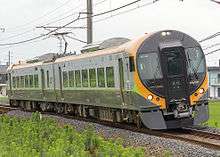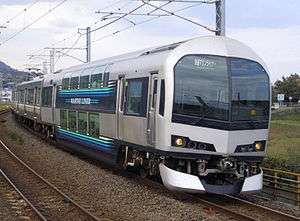8600 series
| 8600 series | |
|---|---|
 Sets E14+E12+E1 on a combined Ishizuchi and Shiokaze service in March 2016 | |
| In service | 23 June 2014 |
| Manufacturer | Kawasaki Heavy Industries |
| Built at | Kobe |
| Replaced | 2000 series, 8000 series |
| Constructed | 2014–2018 |
| Number built | 17 vehicles (7 sets) |
| Formation | 2/3 cars per set |
| Fleet numbers | E1–E3, E11–E14 |
| Capacity |
153 (3 car sets) 101 (2 car sets) |
| Operator(s) | JR Shikoku |
| Depot(s) | Matsuyama Depot |
| Line(s) served | Yosan Line |
| Specifications | |
| Car body construction | Stainless steel |
| Car length | 20,800 mm (68 ft 3 in) |
| Width | 2,834 mm (9 ft 3.6 in) |
| Height | 3,560 mm (11 ft 8 in) |
| Floor height | 1,105 mm (3 ft 7.5 in) |
| Doors | 2 per side |
| Maximum speed |
130 km/h (80 mph) (service) 140 km/h (85 mph) (design) |
| Power output | 220 kW x 4 per set |
| Electric system(s) | 1,500 V DC |
| Current collection method | Overhead catenary |
| Bogies |
S-DT66 (motored) S-TR66 (trailer) |
| Track gauge | 1,067 mm (3 ft 6 in) |
The 8600 series (8600系) is a tilting limited express electric multiple unit (EMU) train type operated by Shikoku Railway Company (JR Shikoku) in Shikoku, Japan, on Ishizuchi limited express services between Takamatsu and Matsuyama since June 2014, replacing ageing 2000 series diesel multiple unit trains.[1] A total of 17 vehicles are delivered by February 2018, replacing all diesel units on the route.[2]
Design
The trains are built by Kawasaki Heavy Industries to a "retro-future" concept, with black front ends intended to evoke images of a steam locomotive.[3] The exterior livery includes orange and green highlights evoking the satsuma oranges and olives for which the region is famous.[2] Each vehicle is built at a cost of approximately 250 million yen, financed partially by national infrastructure investment subsidies.[2] The trains will operate at a maximum speed of 130 km/h (80 mph) in service, although they have a maximum design capability of 140 km/h (85 mph).[3] Tilting capability enables the trains to negotiate curves with a radius of 600 m or more at a speed 30 km/h (20 mph) higher than the limit for conventional non-tilting trains.[3]
Formations
Three-car sets E1 - E3
The three-car sets, numbered E1 to E3, include "Green" car (first class) accommodation in half of one car, and are formed as follows, with one motored car and two non-powered trailer cars.[4]
| Designation | Mc | T | Tsc |
|---|---|---|---|
| Numbering | 8600 | 8800 | 8700 |
| Weight (t) | 41.9 | 32.1 | 39.0 |
| Capacity | 56 | 68 | 12 green + 17 ordinary) |
| Facilities | Vending machine, toilets | Green car seating, wheelchair space, toilets |
The "Tsc" car is fitted with a single-arm pantograph.[4]
Two-car sets E11 - E14

The two-car sets, numbered E11 to E14, are formed with one motored "M" car and one trailer "T" car, as shown below.
| Designation | Mc | Tc |
|---|---|---|
| Numbering | 8600 | 8750 |
| Weight (t) | 41.9[Note 1] | 38.6[Note 2] |
| Capacity | 56 | 45 |
| Facilities | Vending machine, toilets | Wheelchair space, toilets |
Notes
The "Tc" car is fitted with a single-arm pantograph.[3]
 Car 8602 of set E12
Car 8602 of set E12 Car 8752 of set E12
Car 8752 of set E12
Interior
Passenger accommodation consists of ordinary-class 2+2 abreast reclining seats with a seat pitch of 980 mm (39 in) and "Green car" (first class) 2+1 abreast reclining seats with a seat pitch of 1,170 mm (46 in).[4] Each seat is provided with an AC power outlet.[3] The "Mc" car has a "Fresh Green" theme with light-green and dark-green seat covers; the "Tc" car has a "Shine Orange" theme, with orange and brown seat covers.[3] The "Tc" car has a wider (900 mm) door for wheelchair accessibility, and includes a wheelchair space and universal access toilet. LED lighting is used throughout.[3]
 Interior of car 8601
Interior of car 8601 Interior of car 8751
Interior of car 8751
History

The first two pre-series set, E11 and E12, were delivered to Takamatsu Depot from the Kawasaki Heavy Industries factory in Kobe in February 2014.[5] Test running commenced in March.[6] The trains entered service on Ishizuchi limited express services between Takamatsu and Matsuyama on 23 June 2014.[7]
The next four full-production sets (three-car sets E1 and E2 and two-car sets E13 and E14) were delivered from Kawasaki Heavy Industries in October 2015.[8]
References
| Wikimedia Commons has media related to JR Shikoku 8600. |
- ↑ 特急形直流電車の新製について [New DC limited express trains to be built]. News release (in Japanese). Japan: Shikoku Railway Company. 25 November 2013. Archived from the original on 4 December 2013. Retrieved 26 November 2013.
- 1 2 3 JR四国、21年ぶり電車新造 14年6月に高松―松山間 [JR Shikoku to build new trains for first time in 21 years - In service between Takamatsu and Matsuyama from June 2014]. Nikkei Shimbun (in Japanese). Japan: Nikkei Inc. 26 November 2013. Retrieved 26 November 2013.
- 1 2 3 4 5 6 7 8600系量産先行車 [8600 series pre-series trainsets]. Japan Railfan Magazine (in Japanese). 54 (637): 57–61. May 2014.
- 1 2 3 Yoshimoto, Eisaburo (January 2016). 8600系量産車 [8600 series full-production trainsets]. Japan Railfan Magazine (in Japanese). 56 (657): 65–69.
- ↑ 新型特急車輌8600系甲種輸送される [New 8600 series limited express trains delivered]. RM News (in Japanese). Japan: Neko Publishing Ltd. 27 February 2014. Retrieved 27 February 2014.
- ↑ "JR四国8600系の試運転が始まる" [JR Shikoku 8600 series test running starts]. Japan Railfan Magazine Online (in Japanese). Japan: Koyusha Co., Ltd. 7 March 2014. Retrieved 21 March 2014.
- ↑ "JR四国8600系が営業運転を開始" [JR Shikoku 8600 series enters revenue service]. Japan Railfan Magazine Online (in Japanese). Japan: Koyusha Co., Ltd. 24 June 2014. Retrieved 24 June 2014.
- ↑ JR四国8600系の量産車が出場 [JR Shikoku 8600 series full-production sets delivered]. Japan Railfan Magazine Online (in Japanese). Japan: Koyusha Co., Ltd. 9 October 2015. Retrieved 9 October 2015.
Further reading
- "8600系量産先行者" [8600 series pre-series trains]. Japan Railfan Magazine. 54 (638): 60–66. June 2014.
